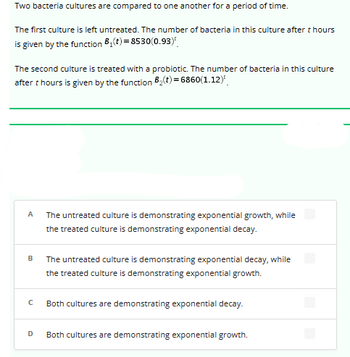
Calculus: Early Transcendentals
8th Edition
ISBN: 9781285741550
Author: James Stewart
Publisher: Cengage Learning
expand_more
expand_more
format_list_bulleted
Question

Transcribed Image Text:Two bacteria cultures are compared to one another for a period of time.
The first culture is left untreated. The number of bacteria in this culture after t hours
is given by the function B₁(t)=8530(0.93)
The second culture is treated with a probiotic. The number of bacteria in this culture
after thours is given by the function B₂(t)=6860(1.12)
A
B
с
D
The untreated culture is demonstrating exponential growth, while
the treated culture is demonstrating exponential decay.
The untreated culture is demonstrating exponential decay, while
the treated culture is demonstrating exponential growth.
Both cultures are demonstrating exponential decay.
Both cultures are demonstrating exponential growth.
Expert Solution
This question has been solved!
Explore an expertly crafted, step-by-step solution for a thorough understanding of key concepts.
This is a popular solution
Trending nowThis is a popular solution!
Step by stepSolved in 3 steps with 11 images

Knowledge Booster
Similar questions
- Find the inverse of each function Зх + 4 1. f(x) = 3(x – 5) + 9 2. f (x) = %3D 16arrow_forwardYou want to estimate how many fish there are in a small pond. Let's suppose that you first capture n1=500 fish, tag them, and throw them back into the pond. After a couple of days you go back to the pond and capture n2=120 fish, of which k=30 are tagged. Estimate the number of fish in the pond. There are approximately Answer fish in the pond.arrow_forwardThe equation n = 0.03t² 0.58t + 3.98, models, n, the number (in millions) of people who moved to another state in the year that is t years since 1990. The table below shows some of the data that were used to find this model. Year 1995 1998 2001 2004 2006 Number of People Who Moved to Another State (millions) a. When t = 1.8 1.2 1.1 1.5 2.1 0 what is the value of n? What does it mean in this situation? Select an answer b. Estimate the number of people who moved to another state in 2005. million (Round to the nearest tenth of a million.) c. Predict the number of people who moved to another state in 2014. million (Round to the nearest tenth of a million.)arrow_forward
- Estimate f(−1.99,−1.03) given that f(−2,−1)=−3, fx(−2,−1)=4, and fy(−2,−1)=1.arrow_forwardAfter t hours of work, a bank clerk can process checks at a rate of r(t) = t² + 90t + 5 checks per hour. How many checks will the clerk process in the first three hours (time 0 to 3 hours)? (Note: Do not include any units in your answer. For example: If you answer is 2 checks write 2)arrow_forwardA large tank is filled to capacity with 700 gallons of pure water. Brine containing 4 pounds of salt per gallon is pumped into the tank at a rate of 7 gal/min. The well-mixed solution is pumped out at a rate of 14 gals/min. Find the number A(t) of pounds of salt in the tank at time t. A(t) =. lbarrow_forward
arrow_back_ios
arrow_forward_ios
Recommended textbooks for you
 Calculus: Early TranscendentalsCalculusISBN:9781285741550Author:James StewartPublisher:Cengage Learning
Calculus: Early TranscendentalsCalculusISBN:9781285741550Author:James StewartPublisher:Cengage Learning Thomas' Calculus (14th Edition)CalculusISBN:9780134438986Author:Joel R. Hass, Christopher E. Heil, Maurice D. WeirPublisher:PEARSON
Thomas' Calculus (14th Edition)CalculusISBN:9780134438986Author:Joel R. Hass, Christopher E. Heil, Maurice D. WeirPublisher:PEARSON Calculus: Early Transcendentals (3rd Edition)CalculusISBN:9780134763644Author:William L. Briggs, Lyle Cochran, Bernard Gillett, Eric SchulzPublisher:PEARSON
Calculus: Early Transcendentals (3rd Edition)CalculusISBN:9780134763644Author:William L. Briggs, Lyle Cochran, Bernard Gillett, Eric SchulzPublisher:PEARSON Calculus: Early TranscendentalsCalculusISBN:9781319050740Author:Jon Rogawski, Colin Adams, Robert FranzosaPublisher:W. H. Freeman
Calculus: Early TranscendentalsCalculusISBN:9781319050740Author:Jon Rogawski, Colin Adams, Robert FranzosaPublisher:W. H. Freeman
 Calculus: Early Transcendental FunctionsCalculusISBN:9781337552516Author:Ron Larson, Bruce H. EdwardsPublisher:Cengage Learning
Calculus: Early Transcendental FunctionsCalculusISBN:9781337552516Author:Ron Larson, Bruce H. EdwardsPublisher:Cengage Learning

Calculus: Early Transcendentals
Calculus
ISBN:9781285741550
Author:James Stewart
Publisher:Cengage Learning

Thomas' Calculus (14th Edition)
Calculus
ISBN:9780134438986
Author:Joel R. Hass, Christopher E. Heil, Maurice D. Weir
Publisher:PEARSON

Calculus: Early Transcendentals (3rd Edition)
Calculus
ISBN:9780134763644
Author:William L. Briggs, Lyle Cochran, Bernard Gillett, Eric Schulz
Publisher:PEARSON

Calculus: Early Transcendentals
Calculus
ISBN:9781319050740
Author:Jon Rogawski, Colin Adams, Robert Franzosa
Publisher:W. H. Freeman


Calculus: Early Transcendental Functions
Calculus
ISBN:9781337552516
Author:Ron Larson, Bruce H. Edwards
Publisher:Cengage Learning